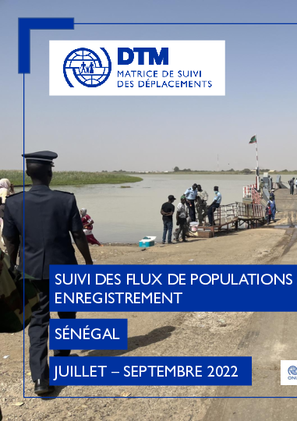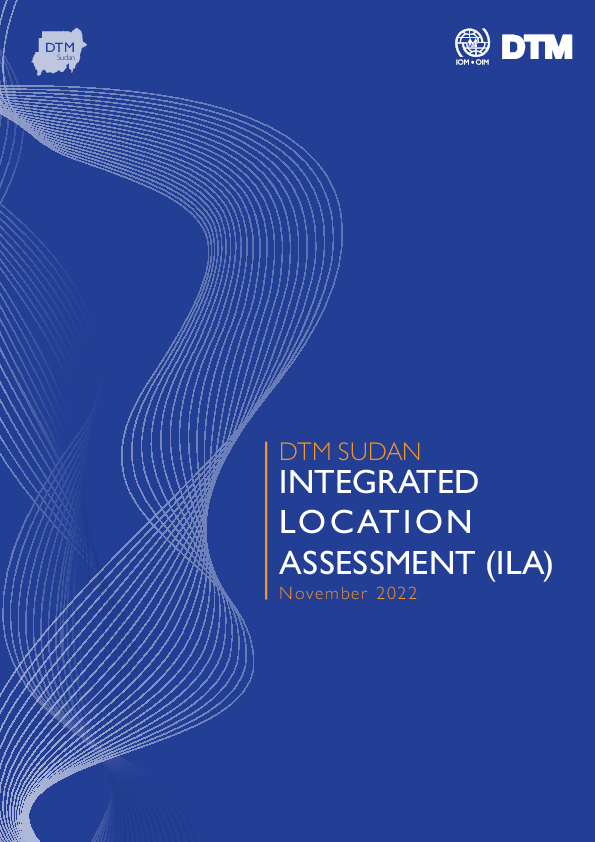-
Countries
-
Data and Analysis
-
Special Focus
-
Crisis Responses

Contact
Regional Office Dakar, RODakarepcteam@iom.int
Language
French
Location
Senegal
Period Covered
Jul 01 2022
Sep 30 2022
Activity
- Flow Monitoring
Afin de mieux comprendre les mouvements et tendances migratoires en Afrique de l’Ouest et du Centre, l’OIM, à travers la Matrice de suivi des déplacements (Displacement Tracking Matrix, DTM), met en œuvre l’activité de Suivi des flux de populations (Flow Monitoring, FM).
Le suivi des flux, qui est mis en œuvre en étroite collaboration avec les autorités et des partenaires nationaux et locaux, est composé de deux outils : l’enregistrement des flux (Flow Monitoring Registry, FMR), qui recueille des données clés sur l’ampleur, la provenance, la destination et les modalités des flux, et les enquêtes individuelles (Flow Monitoring Survey, FMS), conduites auprès des voyageurs afin d’obtenir des informations sur les profils, les parcours migratoires et les intentions des migrants. Le suivi des flux de populations récolte ainsi des données clés sur les flux et les tendances migratoires, les profils des voyageurs, les parcours et intentions des migrants, afin de fournir une meilleure compréhension des mobilités en Afrique de l’Ouest et du Centre.
Au Sénégal, depuis 2017, plusieurs points de suivi des flux de populations (FMP) ont été progressivement installés dans d'importantes localités du Sénégal pour faire le suivi des flux migratoires dans le pays récolter des données sur les tendances de mobilité, les profils et les parcours des voyageurs dans le pays.
Après un arrêt des activités entre avril 2021 et mai 2022 marqué par la fermeture des points existants, la collecte de données a repris avec l’ouverture d'un nouveau site à Rosso (Sénégal), permettant de faire le suivi des dynamiques migratoires depuis le nord du Sénégal, zone de passage de la route méditerranéenne occidentale, et des mouvements entre le Sénégal et la Mauritanie.
Ce rapport présente les données collectées pendant le deuxième trimestre de l’année 2022 (juillet à septembre 2022), au niveau du seul FMP actifs au Sénégal.

Contact
rodakar-dataresearch@iom.int
Language
English
Location
The Gambia
Period Covered
Jul 01 2022
Sep 30 2022
Activity
- Survey
- Flow Monitoring Survey
In order to gain a better understanding of mobility flows and trends throughout West and Central Africa, the International Organization for Migration (IOM) implements the Displacement Tracking Matrix’s Flow Monitoring (FM) tool at key transit points across the region.
Flow Monitoring activities are conducted in close cooperation with national and local authorities as well as with local partners. The Flow Monitoring tool consists of two main components: the Flow Monitoring Registry (FMR), which captures key data on the magnitude, origin, destination and mode of travel of mobility flows, and the Flow Monitoring Survey (FMS), for which individual surveys are conducted with travellers to gather detailed information about the profiles, migration experience and intentions of migrants. Through these activities, the Flow Monitoring tool collects data on migration flows and trends, traveller profiles, migration journeys and intentions of migrants in order to obtain a deeper view of mobility in West and Central Africa.
In The Gambia, DTM conducts Flow Monitoring activities at several important transit locations: in 1) Barra (FMPs are located at the ferry terminal and the main garage);
2) Farafenni (FMPs are located at Farafenni main garage, Farafenni Ballan-Ghar garage, Farafenni McCarthy and Sanjally garage, Farafenni turntable garage and the truck garage); 3) Basse (FMPs are situated at the main garage and the bus station in Basse Santa-Su) and 4) Brikama (FMPs are located at the main garage and the Bus station).
This activities enable DTM to monitor the movements of passenger within The Gambia, out of and towards The Gambia as well as transiting The Gambia.
This report presents the key results from the Flow Monitoring Survey conducted with travellers between July to September 2022. The report presents data collected on flows, routes, provenance, destination and demographic profiles of travellers observed at the FMPs.
Additional information on Flow Monitoring methodology is available on the last page.
Contact
DTMMali@iom.int
Location
Mali
Activity
- Mobility Tracking
- Baseline Assessment
Period Covered
Aug 01 2022 -Aug 31 2022
A baseline assessment is a sub-component of mobility tracking. It aims to collect data on IDP, migrant or returnee population presence in a defined administrative area of the country.
Population Groups
Survey Methodology
Unit of Analysis Or Observation
Type of Survey or Assessment
Keywords
Geographical Scope
Administrative boundaries with available data
The current dataset covers the following administrative boundaries

Contact
DTM Somalia, IOMSomaliaDTM@iom.int
Language
English
Location
Somalia
Period Covered
Oct 15 2022
Oct 31 2022
Activity
- Flow Monitoring
A total of 13,007 movements were observed between the 15th and 31st of October, 2022, representing a similar trend to 2021 when 14,207 movements were observed during the same period. Regional differences were observed. If compared with October 2021, Elayo (90%), Dhobley (31%) and Harirad (14%) FMPs recorded an increase in movements; while Cabudwaaq (-86%), Lowyacado (-36%), Buuhoodle (-13%), Doolow (-11%) and Bossasso (-5%) FMPs observed a decrease. Buuhoodle (30%), Dhobley (26%) and Doolow (23%) FMPs recorded the highest numbers of incoming flows, while Bossaso (36%), Doolow (39%) and Elayo (13%) recorded the highest numbers of outgoing flows.
Contact
DTM Libya, DTMLibya@iom.int
Language
English
Location
Libya
Snapshot Date
Oct 31 2022
Activity
- Mobility Tracking
- Site Assessment
Detention Centre Profiling is a component of IOM Libya’s Displacement Matrix programme. It is a data oriented tool that routinely provides specific sex and age demographic data and key sectorial information on individuals held in Libya’s detention centres on the date of assessment.

Contact
dtmhaiti@iom.int
Language
French
Location
Haiti
Period Covered
Nov 05 2022
Nov 11 2022
Activity
- Event Tracking
Une recrudescence des affrontements entre gangs rivaux, ainsi que l'éruption de manifestations parfois violentes, des pillages, pénuries de biens essentiels et le blocage d'axes routiers et ports dans la Zone métropolitaine de Port-au-Prince (ZMPP) au cours des derniers mois ont accrû l'insécurité déjà présente et ont aggravé une situation économique déjà précaire. Cette situation s'est accompagnée, ces dernières semaines, d'une flambée épidemique de choléra. Tout cela a contribué à des déplacements urbains à grande échelle.
Ce rapport présente les résultats de l'évaluation hebdomadaire des déplacements et de la situation humanitaire effectuée par le système d'alerte précoce du ZMPP. 917 nouveaux déplacements (-42% par rapport à la période d'évaluation précédente) et 876 nouvelles arrivées (+6% par rapport à la période d'évaluation précédente) de personnes déplacées internes ont été rapportés pendant la période d’évaluation dans les 373 quartiers évalués. La plupart de ces déplacements ont eu lieu dans les communes de Croix-des-Bouquets (86%), Tabarre (5%) et Pétion-Ville (5%). Durant la période d’évaluation du 29 octobre au 5 novembre, la DTM avait observé 1 585 nouveaux déplacements et 819 nouvelles arrivées de personnes déplacées dans 303 quartiers évalués.
La situation sécuritaire reste toujours tendue, avec 81 quartiers affectés par l'insécurité (-16% par rapport à la période d'évaluation précédente) et 57 par des violences généralisées (+24%). 46 quartiers (+48% par rapport à la période d'évaluation précédente) ont signalé une flambée épidémique de choléra dans le contexte de la résurgence des cas de choléra en Haïti, qui au 15 novembre 2022 avait conduit au décès de 169 personnes dans le pays. Dix-huit quartiers étaient situés à Cité Soleil, les autres étant situés à Port-au-Prince (11), Carrefour (7), Delmas (5), Tabarre (3), et Pétion-Ville (2).
Contact
DTM Cameroon, DTMCameroon@iom.int
Location
Cameroon
Activity
- Mobility Tracking
- Site Assessment
- Village Assessment
Period Covered
Aug 11 2022 -Aug 24 2022
The Multi-Sectoral Needs Assessment (MSNA) aims to provide an overview of the sectoral needs of affected populations in localities hosting displaced populations to the humanitarian partners and enables them to provide assistance.
Population Groups
IDPs
Other
Returnee (Previously Displaced Abroad)
Returnee (Previously Internally Displaced)
Survey Methodology
Unit of Analysis Or Observation
Site or Location
Type of Survey or Assessment
Household
Keywords
Geographical Scope Partial Coverage
Administrative boundaries with available data
The current dataset covers the following administrative boundaries

Contact
dtmsudan@iom.int
Language
English
Location
Sudan
Period Covered
Dec 15 2021
Jan 16 2022
Activity
- Mobility Tracking
This publication presents the first Integrated Location Assessment (ILA) conducted by DTM Sudan. ILA reports are utilised to enhance and provide accurate and up-to-date information on access to services at major sites of displacement, alongside profiles of displaced and returnee populations. The purpose of this exercise is to determine a severity level of living conditions of returnees and IDPs, allowing partners to better strategize for resources and operations in vulnerable areas as well as mitigate migration risks of push and pull factors. This exercise supports a more specific set of coherent interventions that bridge humanitarian, recovery, peacebuilding, and stabilisation needs.
Contact
DTM Yemen, iomyemendtm@iom.int
Location
Yemen
Activity
- Mobility Tracking
- Event Tracking
Period Covered
Nov 13 2022 -Nov 19 2022
IOM Yemen DTM’s Rapid Displacement Tracking (RDT) tool collects data on estimated numbers of households forced to flee on a daily basis from their locations of origin or displacement, allowing for regular reporting of new displacements in terms of estimated numbers, geography, and needs. It also tracks returnees who returned to their location of origin.
From 1 January to 19 November 2022, IOM Yemen DTM tracked 9,497 households (HH) (56,982 Individuals) who experienced displacement at least once.
Between 13 and 19 November 2022, IOM Yemen DTM tracked 125 households (750 individuals) displaced at least once. The majority of people moved into/within the following governorates and districts:
- Lahj (69 HHs) – Al Qubaytah (55 HHs), Al Musaymir (7 HHs), Tuban (7 HHs) districts. Most displacements in the governorate originated from Lahj and Taiz.
- Al Maharah (13 HHs) – Al Ghaydhah (8 HHs), Qishn (4 HHs), Al Masilah (1 HH) districts. Most displacements in the governorate originated from Al Hodeidah and Taiz.
- Abyan (9 HHs) – Zinjibar (6 HHs), Khanfar (3 HHs) districts. Most displacements in the governorate originated from Taiz.
- Taiz (48 HHs) – Dimnat Khadir (27 HHs), Maqbanah (7 HHs), At Taiziyah (6 HHs) districts.
- Lahj (43 HHs) – Al Qubaytah (31 HHs), Al Musaymir (12 HHs) districts.
- Al Hodeidah (17 HHs) – Al Jarrahi (8 HHs), Al Marawiah (3 HHs), Zabid (2 HHs) districts.
Population Groups
Survey Methodology
Unit of Analysis Or Observation
Type of Survey or Assessment
Keywords
Geographical Scope
Administrative boundaries with available data
The current dataset covers the following administrative boundaries

Contact
DTM Yemen, iomyemendtm@iom.int
Language
English
Location
Yemen
Period Covered
Nov 13 2022
Nov 19 2022
Activity
- Mobility Tracking
IOM Yemen DTM’s Rapid Displacement Tracking (RDT) tool collects data on estimated numbers of households forced to flee on a daily basis from their locations of origin or displacement, allowing for regular reporting of new displacements in terms of estimated numbers, geography, and needs. It also tracks returnees who returned to their location of origin.
From 1 January to 19 November 2022, IOM Yemen DTM tracked 9,497 households (HH) (56,982 Individuals) who experienced displacement at least once.
Between 13 and 19 November 2022, IOM Yemen DTM tracked 125 households (750 individuals) displaced at least once. The majority of people moved into/within the following governorates and districts:
- Lahj (69 HHs) – Al Qubaytah (55 HHs), Al Musaymir (7 HHs), Tuban (7 HHs) districts. Most displacements in the governorate originated from Lahj and Taiz.
- Al Maharah (13 HHs) – Al Ghaydhah (8 HHs), Qishn (4 HHs), Al Masilah (1 HH) districts. Most displacements in the governorate originated from Al Hodeidah and Taiz.
- Abyan (9 HHs) – Zinjibar (6 HHs), Khanfar (3 HHs) districts. Most displacements in the governorate originated from Taiz.
The majority of people moved from the following governorates and districts:
- Taiz (48 HHs) – Dimnat Khadir (27 HHs), Maqbanah (7 HHs), At Taiziyah (6 HHs) districts.
- Lahj (43 HHs) – Al Qubaytah (31 HHs), Al Musaymir (12 HHs) districts.
- Al Hodeidah (17 HHs) – Al Jarrahi (8 HHs), Al Marawiah (3 HHs), Zabid (2 HHs) districts.
